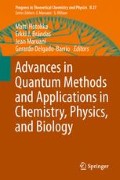Abstract
Isomeric alternatives to usual metal-hydrides as hydrogen-storage materials are considered. Presented are results of ab initio calculations for Be n (n≤18) clusters with up to two endohedral H2 molecules which undergo in-cage dissociation. The systems structures and stabilities are discussed, including energy barriers for hydrogen exit from the cage. The origin of the observed metastability, allowing for a lower-temperature release of H2, is explored. Preservation of the cage integrity and hydrogen confinement is investigated when such core-shell units are merged into larger assemblies structurally resembling fragments of hydrogen-filled metal nanofoams, possible isomeric forms of metal-hydride solid. Different “nanofoam” isomers are composed of pairs or single H atoms suspended electrostatically inside the metal cage units (“nanobubbles”). Interesting features include simultaneous exit of two H atoms, etc. Structural extrapolations suggest potential hydrogen storage capacity up to ∼10 weight-%.
Access this chapter
Tax calculation will be finalised at checkout
Purchases are for personal use only
References
Graetz J (2009) Chem Soc Rev 38:73
Wagemans RWP et al. (2005) J Am Chem Soc 127:16675
Harder S et al. (2011) Angew Chem, Int Ed 50:4156
Srinivasu K et al. (2012) RSC Adv 2:2914
Bandaru S et al. (2012) Int J Quant Chem 112:695
Wang L et al. (2009) J Comput Chem 30:2509
Henry DJ, Yarovsky I (2009) J Phys Chem A 113:2565
McNelles P, Naumkin FY (2009) Phys Chem Chem Phys 11:2858
Allouche A (2008) Phys Rev B 78:085429
Lingam CB et al. (2011) Comput Theor Chem 963:371
Sun Y, Fournier R (2005) Comput Lett 1:1
Boys SF, Bernardi F (1970) Mol Phys 19:553
Valiev M et al. (2010) NWChem, version 6.x. Comput Phys Commun 181:1477
Reed AE, Curtiss LA, Weinhold F (1988) Chem Rev 88:899
Naumkin FY, Wales DJ (2012) Int J Quant Chem 112:3068
Naumkin FY, Wales DJ (2011) J Phys Chem A 115:12105
Naumkin FY, Wales DJ (2012) Chem Phys Lett 545:44
Skorb EV et al. (2010) Nanoscale 2:722
Acknowledgements
The authors thank the RSC and the NSERC of Canada for the financial support of this work via a travel grant to FN. The staff of the HPC facilities of the UOIT Faculty of Science and of the Sharcnet network of Ontario are acknowledged for their invaluable technical support. FN is grateful to the University of Cambridge Department of Chemistry for their hospitality during his sabbatical visit.
Author information
Authors and Affiliations
Corresponding author
Editor information
Editors and Affiliations
Rights and permissions
Copyright information
© 2013 Springer International Publishing Switzerland
About this paper
Cite this paper
Naumkin, F.Y., Wales, D.J. (2013). Hydrogen in Light-Metal Cage Assemblies: Towards a Nanofoam Storage. In: Hotokka, M., Brändas, E., Maruani, J., Delgado-Barrio, G. (eds) Advances in Quantum Methods and Applications in Chemistry, Physics, and Biology. Progress in Theoretical Chemistry and Physics, vol 27. Springer, Cham. https://doi.org/10.1007/978-3-319-01529-3_12
Download citation
DOI: https://doi.org/10.1007/978-3-319-01529-3_12
Publisher Name: Springer, Cham
Print ISBN: 978-3-319-01528-6
Online ISBN: 978-3-319-01529-3
eBook Packages: Chemistry and Materials ScienceChemistry and Material Science (R0)

